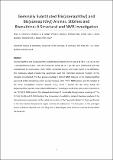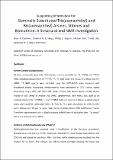Files in this item
Geminally substituted tris(acenaphthyl) and bis(acenaphthyl) arsines, stibines and bismuthine : a structural and nuclear magnetic resonance investigation
Item metadata
| dc.contributor.author | Chalmers, Brian Alexander | |
| dc.contributor.author | Meigh, Christina | |
| dc.contributor.author | Nejman, Phillip | |
| dc.contributor.author | Buehl, Michael | |
| dc.contributor.author | Lebl, Tomas | |
| dc.contributor.author | Woollins, J Derek | |
| dc.contributor.author | Slawin, Alexandra Martha Zoya | |
| dc.contributor.author | Kilian, Petr | |
| dc.date.accessioned | 2017-06-24T23:33:53Z | |
| dc.date.available | 2017-06-24T23:33:53Z | |
| dc.date.issued | 2016-07-18 | |
| dc.identifier | 243729568 | |
| dc.identifier | c3c77594-ad70-4a8b-9262-3aa4543de8f4 | |
| dc.identifier | 84978696472 | |
| dc.identifier | 000380181400040 | |
| dc.identifier.citation | Chalmers , B A , Meigh , C , Nejman , P , Buehl , M , Lebl , T , Woollins , J D , Slawin , A M Z & Kilian , P 2016 , ' Geminally substituted tris(acenaphthyl) and bis(acenaphthyl) arsines, stibines and bismuthine : a structural and nuclear magnetic resonance investigation ' , Inorganic Chemistry , vol. 55 , no. 14 , pp. 7117-7125 . https://doi.org/10.1021/acs.inorgchem.6b01079 | en |
| dc.identifier.issn | 0020-1669 | |
| dc.identifier.other | ORCID: /0000-0002-0269-3221/work/48131693 | |
| dc.identifier.other | ORCID: /0000-0002-1095-7143/work/48131745 | |
| dc.identifier.other | ORCID: /0000-0002-2999-2272/work/55901225 | |
| dc.identifier.other | ORCID: /0000-0002-9527-6418/work/56861336 | |
| dc.identifier.other | ORCID: /0000-0001-6379-3026/work/58285391 | |
| dc.identifier.other | ORCID: /0000-0002-1498-9652/work/31779160 | |
| dc.identifier.uri | https://hdl.handle.net/10023/11076 | |
| dc.description | This work was financially supported by the EPSRC and COST actions CM0802 PhoSciNet and SM1302 SIPs. The authors would like to thank the University of St Andrews NMR Service and the EPSRC UK National Mass Spectrometry Facility at Swansea University (NMSF). | en |
| dc.description.abstract | Tris(acenaphthyl) and bis(acenaphthyl) substituted pnictogens (iPr2P-Ace)3E ( 2 – 4 ) (E = As, Sb, Bi; Ace = acenaphthene-5,6-diyl) and (iPr2P-Ace)2EPh ( 5 and 6 ), (E = As, Sb) were synthesised and fully characterised by multinuclear NMR, HRMS, elemental analysis and single crystal X-ray diffraction. The molecules adopt propeller-like geometries with the restricted rotational freedom of the sterically encumbered iPr2P-Ace groups resulting in distinct NMR features. In the tris(acenaphthyl) species ( 2 – 4 ) the phosphorus atoms are isochronous in the 31P{1H} NMR spectra, and the rotation of the three acenaphthyl moieties around E–Cipso bond is locked. On the other hand, the bis(acenaphthyl) species show a fluxional behaviour, resulting in an AX to A2 spin system transition in the 31P{1H} VT NMR spectra. This allowed elucidation of remarkable through-space couplings of 8TSJPP 11.5 Hz (for 5 ) and 25.8 Hz (for 6 ) at low temperature. In addition, detailed lineshape analysis of the thermodynamic parameters of the restricted rotation of the “propeller blades” in 5 was performed in the intermediate temperature region and also at coalescence. The lone pairs on the pnictogen atoms in 2 – 6 are oriented such that they form a bowl shaped area which is somehow buried within the molecule. | |
| dc.format.extent | 9 | |
| dc.format.extent | 1392145 | |
| dc.format.extent | 1539417 | |
| dc.language.iso | eng | |
| dc.relation.ispartof | Inorganic Chemistry | en |
| dc.subject | QD Chemistry | en |
| dc.subject | DAS | en |
| dc.subject | BDC | en |
| dc.subject.lcc | QD | en |
| dc.title | Geminally substituted tris(acenaphthyl) and bis(acenaphthyl) arsines, stibines and bismuthine : a structural and nuclear magnetic resonance investigation | en |
| dc.type | Journal article | en |
| dc.contributor.institution | University of St Andrews. School of Chemistry | en |
| dc.contributor.institution | University of St Andrews. EaSTCHEM | en |
| dc.contributor.institution | University of St Andrews. Office of the Principal | en |
| dc.identifier.doi | https://doi.org/10.1021/acs.inorgchem.6b01079 | |
| dc.description.status | Peer reviewed | en |
| dc.date.embargoedUntil | 2017-06-24 | |
| dc.identifier.url | http://pubs.acs.org/doi/suppl/10.1021/acs.inorgchem.6b01079 | en |
This item appears in the following Collection(s)
Items in the St Andrews Research Repository are protected by copyright, with all rights reserved, unless otherwise indicated.


